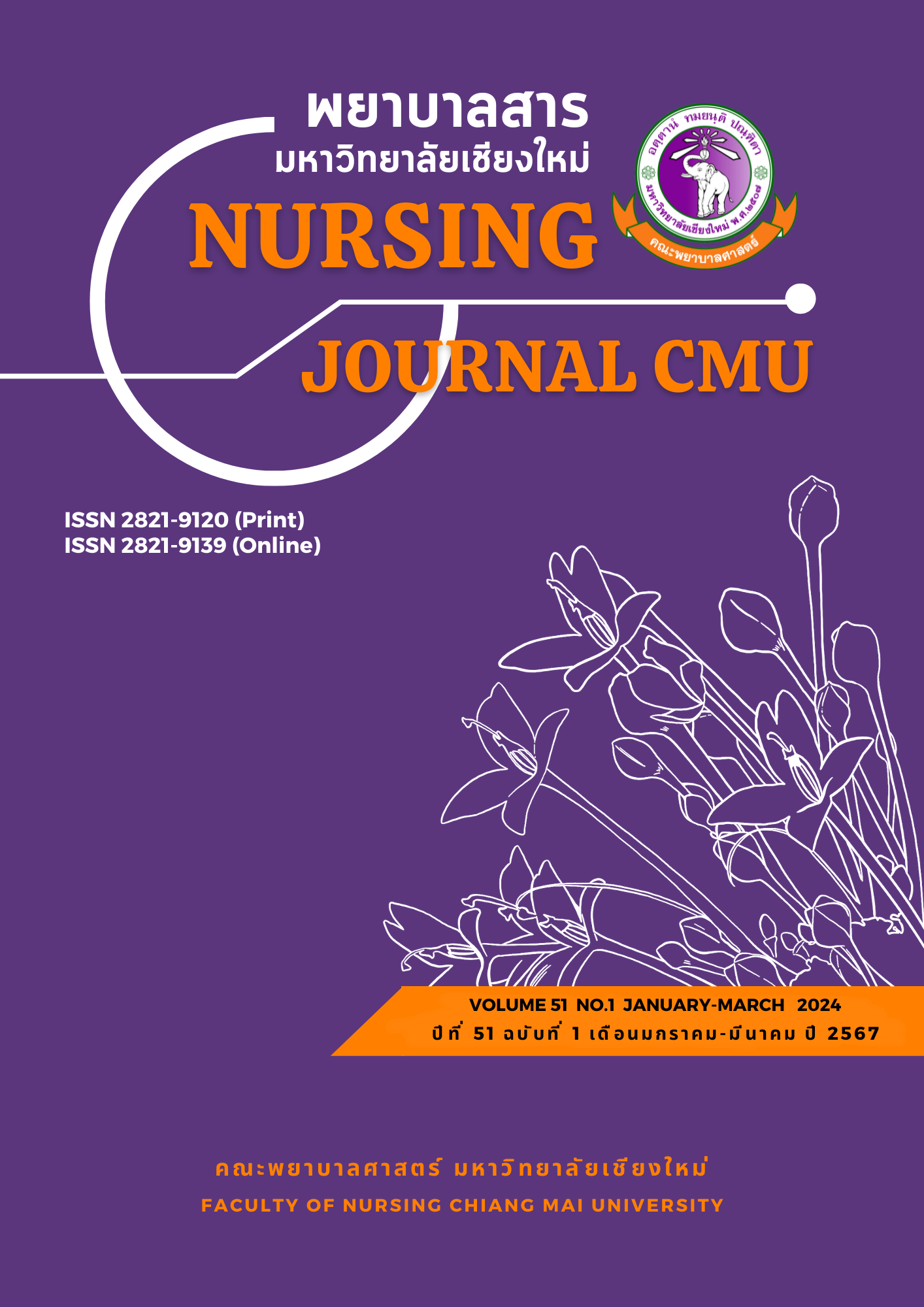ผลของโปรแกรมการเรียนรู้แบบมีส่วนร่วมต่อพฤติกรรมการป้องกันโรคพยาธิใบไม้ตับ ของประชากรกลุ่มเสี่ยงในชุมชน
คำสำคัญ:
โปรแกรมการเรียนรู้แบบมีส่วนร่วม, พฤติกรรมการป้องกันโรคพยาธิใบไม้ตับ, ประชากรกลุ่มเสี่ยงในชุมชนบทคัดย่อ
โรคพยาธิใบไม้ตับเป็นสาเหตุสำคัญที่ทำให้เกิดมะเร็งท่อน้ำดี แม้จะมีการดำเนินการควบคุมโรคพยาธิใบไม้ตับเป็นระยะเวลานาน แต่ยังคงพบอัตราความชุกของโรคอย่างต่อเนื่อง ดังนั้นการมีพฤติกรรมการป้องกันโรคพยาธิใบไม้ตับของประชากรกลุ่มเสี่ยงในชุมชนจึงมีความจำเป็นอย่างยิ่ง การวิจัยกึ่งทดลองครั้งนี้ มีวัตถุประสงค์เพื่อเปรียบเทียบพฤติกรรมการป้องกันโรคพยาธิใบไม้ตับของประชากรกลุ่มเสี่ยงในชุมชน ก่อนและหลังได้รับโปรแกรมการเรียนรู้แบบมีส่วนร่วม และเปรียบเทียบพฤติกรรมการป้องกันโรคพยาธิใบไม้ตับของประชากรกลุ่มเสี่ยงในชุมชนระหว่างกลุ่มที่ได้รับโปรแกรมเป็นระยะเวลา 8 สัปดาห์ และกลุ่มที่ได้รับบริการตามปกติ กลุ่มตัวอย่าง คือ ประชาชนกลุ่มเสี่ยงในชุมชน จำนวน 54 ราย โดยแบ่งเป็นกลุ่มทดลอง 27 ราย และกลุ่มควบคุม 27 ราย ศึกษาในพื้นที่อำเภอบ้านแฮด จังหวัดขอนแก่น เครื่องมือที่ใช้ในการวิจัย คือ โปรแกรมการเรียนรู้แบบมีส่วนร่วมที่พัฒนาโดยผู้วิจัย และเครื่องมือที่ใช้ในการรวบรวมข้อมูล คือ แบบสอบถามพฤติกรรมการป้องกันโรคพยาธิใบไม้ตับ ที่มีค่าดัชนีความตรงตามเนื้อหาทั้งฉบับ (S-CVI) เท่ากับ .99 และหาค่าความเชื่อมั่น โดยใช้สูตร Cronbach's alpha coefficient ได้เท่ากับ .87 วิเคราะห์ข้อมูลด้วยสถิติเชิงพรรณนา สถิติ Mann-Whitney U test และสถิติ Wilcoxon matched pairs singed-ranks test
ผลการวิจัยพบว่า กลุ่มทดลองที่ได้รับโปรแกรมการเรียนรู้แบบมีส่วนร่วมเป็นระยะเวลา 8 สัปดาห์ มีคะแนนเฉลี่ยพฤติกรรมการป้องกันโรคพยาธิใบไม้ตับ (M = 87.66, SD = 3.05) สูงกว่าก่อนได้รับโปรแกรมการเรียนรู้แบบมีส่วนร่วม (M = 71.08, SD = 4.13) อย่างมีนัยสำคัญทางสถิติ (p < .001) และสูงกว่ากลุ่มควบคุมที่ได้รับการบริการตามปกติ (M = 69.56, SD = 2.99) อย่างมีนัยสำคัญสำคัญทางสถิติ (p < .001)
การศึกษาครั้งนี้แสดงให้เห็นว่า โปรแกรมการเรียนรู้แบบมีส่วนร่วมสามารถนำมาใช้ในการส่งเสริมพฤติกรรมการป้องกันโรคพยาธิใบไม้ตับของประชากรกลุ่มเสี่ยงในชุมชน
References
Arin, S., Tamdee, D., & Aungwattana, S. (2021). Effect of the participatory learning program on foot ulcer prevention among uncontrolled type 2 diabetic persons in community. Nursing Journal, 47(3), 121-133.
Ban Haad District Public Health Office. (2021). Liver fluke examination report form, Ban Haad District, year 2021. [Unpublished manuscript].
Burns, N., & Grove, S. (2009). The practice of nursing research: Appraisal, synthesis and generation of evidence (6th ed.). Saunders Elsevier.
Cholangiocarcinoma Research Institute. (2021). Public media: Campaigning of solve the problem about liver fluke and cholangiocarcinoma. https://cascap.kku.ac.th/multimedia/ovcca-media/
Cholangiocarcinoma Research Institute. (2022). Primary prevention report (liver fluke screening with stool and urine tests). https://cloud.cascap.in.th/report84/main-y65
Department of Disease Control, Ministry of Public Health. (2020). Names and key symptoms of dangerous communicable diseases. https://ddc.moph.go.th/
Department of Health Service Support, Ministry of Public Health. (2020). Manual of village health volunteers for surveillance, prevention and control of liver fluke and bile duct cancer. https://ddc.moph.go.th/uploads/publish/1057720201009062730.pdf
Department of Mental Health, Ministry of Public Health. (2000). Participatory training manual. https://www.dmh.go.th/
Hamsompan, K., Charoenpun, C., & Worawong, C. (2016). The effects of program to change behavior for prevention on family leader of opisthorchiasis, Tumbon Ban Phang, Kaset Wisai District, Roi-Et Province. Journal of The Office of DPC 7 Khon Kaen, 23(2), 9-22.
Hughes, T., O’Connor, T., Techasen, A., Namwat, N., Loilome, W., Andrews, R. H., Khuntikeo, N., Yongvanit, P., Sithithaworn, P., & Taylor-Robinson, S. D. (2017.) Opisthorchiasis and cholangiocarcinoma in Southeast Asia: An unresolved problem. International Journal of General Medicine, 10, 227-237. https://doi.org/10.2147/IJGM.S133292
Jantarakolica, K. (2015). Knowledge summary report form from the 1st learning exchange activity, academic, 2014. https://www.rcim.in.th/
Khamdokrab, C., & Vaeteewootacharn, K. (2018). Factors associated with liver fluke infection among people aged 40 years and above at Chumphae District, Khon Kaen Province. Journal of Sakon Nakhon Hospital, 21(3), 75-83.
Kolb, D. A. (1984). Experiential learning: Experience as the source of learning and development. Prentice-Hall.
National Health Commission Office. (2014). Eradication of liver fluke and bile duct cancer problems in the population. https://main.samatcha.org/node/70
National Health Commission Office. (2021). The National Health Assembly set a goal of 10 years to eradicate liver fluke and bile duct cancer. https://www.nationalhealth.or.th/en/node/175
Petmaneechote, K., Pongpumma, L., Arunkeeree, A., & Taowalanon, P. (2021). Effectiveness of participatory learning program on knowledge and practice of village health volunteers for taking care of hypertension patients. Nursing Journal of the Ministry of Public Health, 31(3), 28-41. https://he02.tci-thaijo.org/index.php/tnaph/article/view/255636/173950
Poethapan, S., Iniam, S., Chomchanakul, T., & Prasomruk, P. (2019). Comparison of prevention behavior of liver fluke infection among people between communities municipalities and non-municipal areas in Amnat Charoen District, Amnat Charoen Province. Thai Health Science Journal and Community Public Health, 4(1), 119-129.
Pramoonsin, O., Tamdee, D., & Aungwattana, S. (2020). Effects of participatory learning of family members on knowledge and practice in dietary preparation for older persons with uncontrolled hypertension. Nursing Journal, 47(3), 314-326.
Pruettikul, S. (2015). Knowledge management project, Faculty of Agricultural Technology Burapha University Sa Kaeo Campus: Active learning. https://km.buu.ac.th/article/frontend/article_detail/141
Sithithaworn, P., Yongvanit, P., Duenngai, K., Kiatsopit, N., & Pairojkul, C. (2014). Roles of liver fluke infection as risk factor for cholangiocarcinoma. Journal of Hepato-Biliary-Pancreatic Sciences, 21(5), 301-308. https://doi.org/10.1002/jhbp.62
Wichaiyo, W. (2020). Factors affected for risk of liver fluke disease among people in Kham Muang District, Kalasin Province. SAGE Open Medicine, 13(1), 105-114.
World Health Organization. (2021). Foodborne trematode infections. https://www.who.int/news-room/fact-sheets/detail/foodborne-trematode-infections
Downloads
เผยแพร่แล้ว
How to Cite
ฉบับ
บท
License
Copyright (c) 2024 พยาบาลสาร มหาวิทยาลัยเชียงใหม่

This work is licensed under a Creative Commons Attribution-NonCommercial-NoDerivatives 4.0 International License.
บทความที่ได้รับการตีพิมพ์เป็นลิขสิทธิ์ของวารสารพยาบาลสาร
ข้อความที่ปรากฏในบทความแต่ละเรื่องในวารสารวิชาการเล่มนี้เป็นความคิดเห็นส่วนตัวของผู้เขียนแต่ละท่านไม่เกี่ยวข้องกับมหาวิทยาลัยเชียงใหม่ และคณาจารย์ท่านอื่นๆในมหาวิทยาลัยฯ แต่อย่างใด ความรับผิดชอบองค์ประกอบทั้งหมดของบทความแต่ละเรื่องเป็นของผู้เขียนแต่ละท่าน หากมีความผิดพลาดใด ๆ ผู้เขียนแต่ละท่านจะรับผิดชอบบทความของตนเองแต่ผู้เดียว





